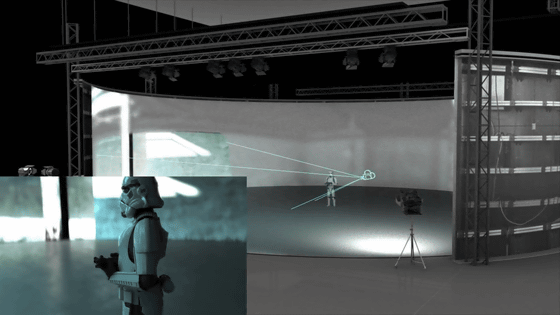Star Wars' first live-action drama `` Mandalorian '' introduces a new shooting method like never before

The setting for Star Wars, known for its opening, 'In the galaxy far away, far away ...' is not on Earth, but on planets and spaceships that no one has ever seen. Therefore, in order to shoot, it is necessary to make a large set or to combine CG images and live action. In the first live-action drama in the Star Wars series, ``
Pioneering a new avenue for Mandalorian production
https://www.unrealengine.com/ja/blog/forging-new-paths-for-filmmakers-on-the-mandalorian
Mandalorian is a live-action drama that George Lucas has dreamed of for many years, but the time and budget given is less than the Star Wars movie. For this reason, Mandalorian cannot make large sets.
Even if you do not set up a large set, you can shoot by combining live action and CG with chroma keying using green screen. However, the prize hunter Mandalorian who is the main character of `` Mandalorian '' always wears armor, and when shooting with a green background, the green color of the background is reflected in the armor, so when combining, the green including the armor The reflection of the back must be handled carefully. This process is also costly, and it is sometimes difficult to produce the whole story with chromakey synthesis.
Under the concept of `` returning real-time interactivity and collaboration to the production process '', John Fabrough, director of production, `` displayed the background rendered in real time with Unreal Engine , a game engine developed by Epic Games. Shooting was adopted for the Mandalorian season 1 shooting.
You can see exactly how 'Mandalorian' is actually shot by looking at the following movie.
The Virtual Production of The Mandalorian, Season One-YouTube
The following are digital photography studios developed by Industrial Light & Magic (ILM). The ILM logo is displayed on a 270 degree LED wall that surrounds the circular stage.

Four PCs with NVIDIA GPUs run Unreal Engine and project walls and ceilings rendered in high resolution in real time on LED walls.

The image projected on the LED wall is rendered after correcting the parallax and lighting according to the viewpoint of the camera. As a result, the background is reproduced without any discomfort.

The actual shooting scene looks like this. In Mandalorian Season 1, more than 50% of the scenes are shot using LED walls.

Sets such as floors and props are assembled inside the LED wall. The following scene is the scenery when nothing is displayed on the LED wall ...

Displaying the room wall and ceiling on the LED wall looks like this.

In the following scenes, the performers and props in the foreground are still captured by the camera, and the background with a slightly out-of-focus image is projected on the LED wall. If you don't know it, you can see it as if you were shooting with a large set.

Professional staff manipulates the scene's background, lighting and effects. Also, it is possible to check in real time on the camera's preview monitor. Also, with the version update, shooting data can be imported to the sequencer, and the environment of the LED wall can be remotely controlled from the iPad.

According to the Unreal Engine development team, `` Mandalorian was not only an exciting challenge, but also a chance to develop tools that will be useful to all users of Unreal Engine and demonstrate them on the production floor. '' 'The techniques and technologies we developed with Mandalorian are just the tip of the iceberg. I'm very excited about what the future will be like.'
Related Posts:







